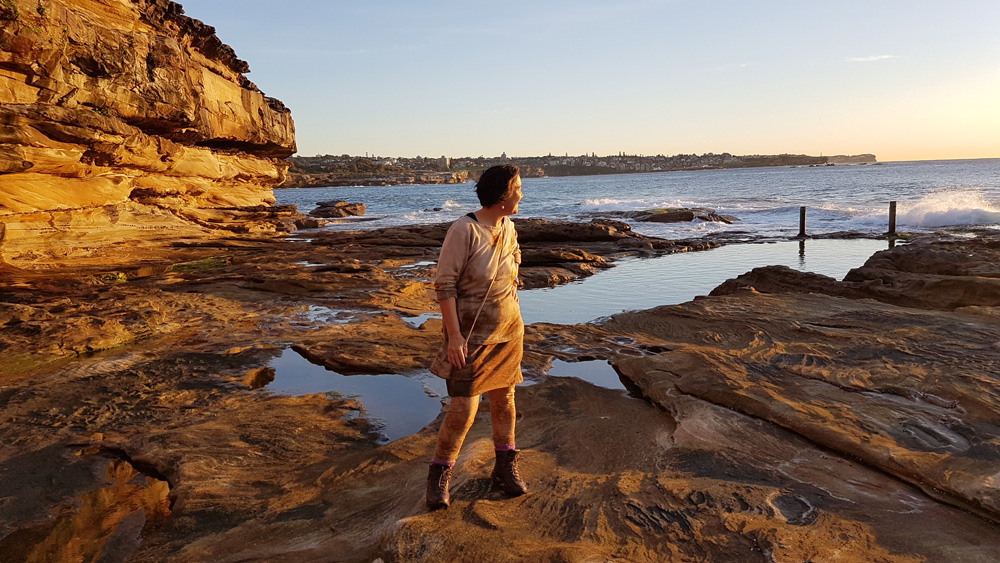By Jane Milburn Textile Beat founder and sustainability consultant

Textile Beat founder Jane Milburn clothed in wool garments given a second life using eco-dye. Photo by Ele Cook
My campaign on clothing waste has been a lifetime in the making. It began as a child learning hand-making skills and continued as a student upcycling big old dresses and thrifted finds.
I made many of my clothes for decades then rediscovered op shops in 2011 after a Fashion for Flood fundraiser. I began visiting op shops and particularly seeking out natural-fibre garments – wool jumpers with a hole, linen shirts with a missing button. The waste of resources troubled me because I grew up on a farm and have an agricultural science degree. What was happening to our clothing culture I wondered?
I fixed and refashioned these finds into office wear for my day job as a communications manager. After doing postgraduate study in leadership, I left corporate life in 2012 to found Textile Beat, a start-up re-thinking contemporary clothing cultures. The evident need for a more ethical approach to clothing was brought into sharp focus by the human tragedy of the Rana Plaza collapse in Bangladesh, and the exploitative nature of fast-fashion supply chains was laid bare.
Through the 365-day Sew it Again project in 2014, I explored upcycling options and blogged every day for 12 months as a platform to explore and speak out about more sustainable clothing cultures. This evolved into a slow clothing philosophy to reduce our material footprint through behaviour change: think, natural, quality, local, care, few, make, adapt, revive and salvage. Textile Beat shares this message with individuals, teachers, creatives, community groups, sustainability groups, universities and governments.
Clothing, like food, is essential for health and wellbeing because clothes do for us on the outside what food does inside – nourishing, warming, influencing the way we feel and how we present to the world. Yet we may be too busy to think through the details of where food and clothing comes from because industrial supply chains currently deliver it so easily and affordably.
The transformational shift during the past two decades in the way we source, use and discard our clothing has major social and environmental implications. With rising international concern about the state of planetary health, it is time to consider ways we as individuals can contribute by living more sustainably.
Clothing is the cheapest it has been in history, mainly due to global supply chains accessing low-wage labour in developing nations. About 90 percent of clothes sold in Australia are now made overseas, mostly in Asian factories with the potential for exploitation of vulnerable workers.
Levels of consumption of apparel fibre have risen markedly as prices have fallen. Based on the annual global average, we now buy twice as much clothing as we did two decades ago, and Australians buy twice the global average. At the same time, there has been a major shift towards clothes made from synthetic fibres derived from petroleum. Two-thirds of new clothing is now synthetic, which research shows is shedding microplastic particles into the ocean with every wash. (Read more)
The outsourcing of clothing manufacture has led to a population-wide loss of knowledge of the making process and disregard for the time and resources involved. This loss of basic sewing skills means an inability to repair, even resew a button, leading to dependency and a lack of autonomy.
The connection between healthy-eating behaviours and teaching children to cook and grow food has been recognised by teachers, health groups, food leaders and governments. The rise of television cooking shows and cooking classes is providing some opportunities to re-learn these skills.
In a similar way, revaluing the skills of mending and making clothing can empower us to make something uniquely individual and reduce our footprint by extending the life of clothing already in circulation. This is the message we share through Textile Beat workshops and talks.
The Slow Clothing Project documents 40 maker stories about Australians choosing to sew something for themselves to wear. This 2016 Textile Beat project showcases a handmade approach to help advance the ethics and sustainability of our clothing story.
Anything old can be new again when we have the skills and willingness to invest the time in doing it. Perhaps we should stop using the term waste? We need to think of fibre and clothing as resources and focus on reducing, reusing and recycling in the context of a shift from a highly consumptive economy to a circular one.
Craig Reucassel and the ABC’s War on Waste highlighted fashion and clothing waste in their third episode of this ground-breaking series.
#waronwasteau #slowclothing #slowclothingphilosophy #slowclothingmanifesto